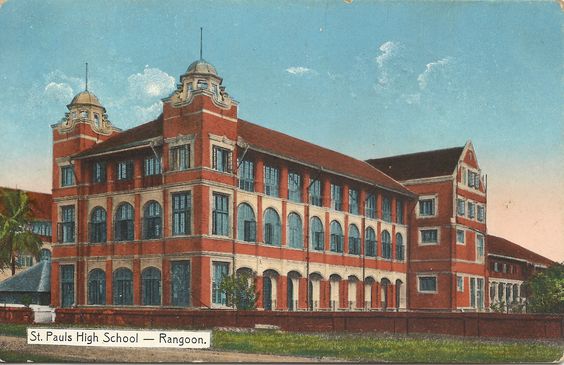Formerly known as St. Paul High School, Yangon’s Basic Education High School (6) Botahtaung is one of the oldest schools in Myanmar, with a list of alumni including many prominent political leaders, intellectuals and artists.
The school was founded by Bishop Paul Bigandet in 1859 in a humble wooden structure near the bishop’s residence on Barr Street (now Mahabandula Park Street). It was moved to the site of Yangon City Hall before being relocated to its present site at the corner of Anawrahta Road and Theinbyu Road in 1886 to accommodate an increasing number of students.
At the time, St. Mary’s, the biggest Roman Catholic cathedral in Myanmar, and the Secretariat had yet to be built. St. Paul High even predates the buildings of Yangon University by two decades. In honor of the bishop, the street in front of the school was named Bigandet Street.
Most of the students at St. Paul High School were British or of mixed parentage. As lessons were taught in English, local people called the school “the English School”. Students were taught English, ancient history, geography, mathematics and other subjects in the three-story brick building designed in the colonial architectural style.
Spacious and well-equipped classrooms lie along its long corridor. The school was complete with sporting facilities for football, tennis, skating and so on. Many St. Paul High students continued their studies at European universities.
Two new wings, designed by then-renowned architect Thomas Swales, were added between 1900 and 1908. Students of St. Paul High School were known for their philanthropic activities, such as serving in the auxiliary fire-fighting force and volunteering to comfort patients in hospitals. When World War I broke out, many students left the school to fight in the Mesopotamian campaign in the Middle East.

Among the prominent students of the school were Burmese-Chinese tycoon Lim Tsing Chong; Sir Maung Khin, the colony’s first Burmese home minister; Sir Joseph Augustus Maung Gyi, the only Burmese governor during the colonial period; Dr. Ba Maw, the first prime minister of the colonial period and later chancellor during the Japanese occupation; U Tin Htut, the first person from Myanmar to become an officer in the Indian Civil Service; U Kaung, the first chairman of the Myanmar Historical Commission; Walter Chit Tun, Myanmar’s first bodybuilder; and renowned cartoonist U Hein Soon.
Artist U Ba Zaw, who introduced Western-style watercolor painting to Myanmar, taught painting at St. Paul High. U Ba Cho, who was assassinated at the Secretariat in 1947 along with General Aung San, the architect of Myanmar’s independence, also studied at the school.
Due to the influence of Christian missionary schools including St. Paul High, people from the lower-middle to the upper classes took pride in taking English names such as Peter, David, Michael, Nancy and Mary. This practice eventually fell out of favor as anti-colonialist sentiment rose among Myanmar’s people, however.
Taw Phaya Galay Aung Zay, the grandson of Myanmar’s last monarch, King Thibaw, who was dethroned and sent into exile in India by the British in 1885, defied school authorities by attending classes wearing traditional Myanmar dress; he would become the first student allowed to wear traditional Myanmar clothing to the school, which had previously required all students to wear pants.
Japanese troops occupied the school campus during World War II. They destroyed a 3-square-foot brass plaque inscribed with an honor roll of St. Paul High School students killed on the Mesopotamian battlefields in World War I.
St. Paul High continued to be managed by priests after World War II. In 1956, Harry Tan, a seventh grader at the school, was shot dead by police as they forcibly dispersed a group of students protesting the government’s cancellation of the seventh-grade state examinations due to the leak of exam questions. He was the first student to be killed in student protests since independence. That year, Prime Minister U Nu issued an order decreeing that all seventh graders be listed as having passed the exam.
In 1965, the xenophobic military regime of dictator General Ne Win nationalized private schools including St. Paul High School. Christian missionaries were forced to leave Myanmar, and Bigandet Street was renamed Anawrahta Road.
The school, which has been at its present site for 134 years, received a Yangon Heritage Trust commemorative Blue Plaque in 2017 designating it as one of the former capital’s heritage buildings.
Translated from Burmese by Thet Ko Ko

















